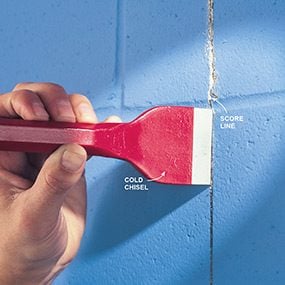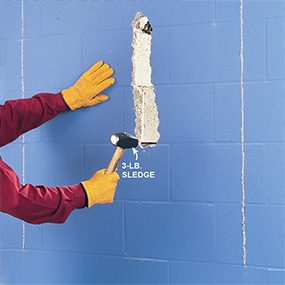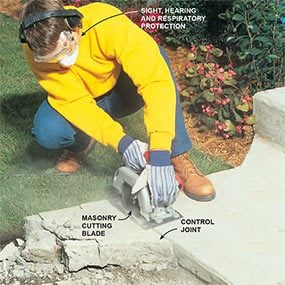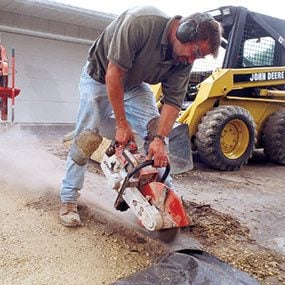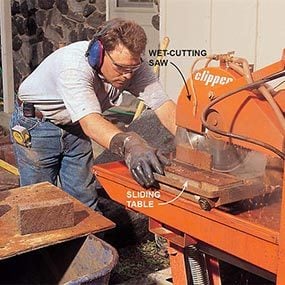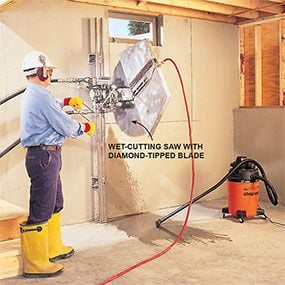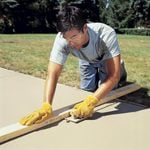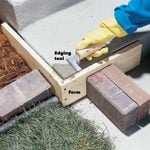How to Cut Concrete
Updated: Feb. 22, 2023Concrete cutting tips for the tough jobs. Try a concrete saw
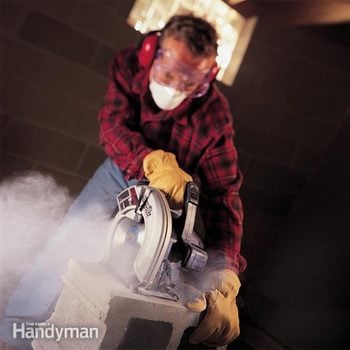
Cutting concrete is a tough job, but it doesn't have to be hard. Whether you're cutting concrete blocks or slabs, walls or floors, here are the easy ways to cut tough concrete.
Easy ways to cut tough concrete
Concrete—most of us have a love-hate relationship with it. Love it when we need a permanent, heavy-duty, weather-resistant surface. Hate it when we gotta repair, replace or cut the stuff.
The prospect of cutting concrete can be daunting, but it doesn’t have to be. Most of the battle can be won by simply selecting the right tools. Try a concrete saw. Following is a rundown of common concrete-cutting tasks—from dinky to monster-sized—and the best tools and techniques for handling them.
Concrete Cutting Tools: Diamond blades are a DIYer’s best friend
You can make small rough cuts using a cold chisel and sledgehammer (Photos 2 and 3), but the better choice is a circular saw with a special blade. Three basic choices are shown in Photo 1:
Types of Blades:
Abrasive corundum masonry blades are inexpensive (under $5 for a 7-in. blade), widely available and capable of cutting through concrete, stucco and asphalt. They’re affordable but not fast—in most situations they’re capable of cutting only shallow 1/4- to 1/2-in. passes, so any cut is time-consuming. They also wear away quickly. A blade that’s 7 inches in diameter at the start of a cut will wear down to 6-1/2 in. after cutting a foot or two along a line—meaning you need to frequently adjust the depth of your saw to expose more blade. Abrasive corundum blades smell, create plumes of fine dust and get so hot they can actually glow. They’re an economical choice when you need to make only a few shallow cuts.
Diamond blades consist of a metal blade with a diamond/metal composite bonded to the perimeter. As the blade cuts, the metal composite slowly wears away, revealing fresh, sharp diamond cutting edges. Diamond blades for a standard 7-in. circular saw are a substantial investment, but since they’ll outlast and outcut dozens of abrasive-type blades, they’re worth the cost if you’re cutting a lot of concrete. Diamond blades fall into two categories:
Dry-cutting diamond blades most often have a serrated or toothed rim (Photo 1) to help cool the blade and eject waste. They work best when you make a series of gradually deeper cuts to avoid overheating the blade. The downside to dry-cutting masonry is the tornado of fine dust it creates. If you cut concrete indoors, seal off the area with plastic and duct tape. Seal all duct openings as well.
Wet-cutting diamond blades can have either teeth or a smooth, continuous perimeter. Water not only helps cool and lubricate the blade but also keeps the dust down. These cut the fastest and cleanest, but they require a special saw that can both distribute water and be safely used around it. As a make-do option, you can plug your saw into a GFCI-protected extension cord and have a helper carefully direct a small stream of water just in front of your saw as it cuts.
If you have just one big project, you’ll save money and time by renting a track-guided, wet-cutting saw/saw blade combination. Rental centers carry walk-behind saws for sawing or scoring concrete slabs, as well as a variety of hand-held saws for other tasks.
NOTE: If a diamond blade stops cutting, it may mean you’re cutting a material that’s too soft. A hard material is necessary to wear away the metal composite that the diamond cutting edges are embedded in. It may seem contrary, but to sharpen the blade, make a few cuts through a harder material to reveal new, sharp diamond edges.
Concrete saw cutting dos and don’ts
- Don’t force a blade into a cut. Let the weight of the saw and the blade do the cutting.
- When dry-cutting, back the blade off and allow it to run free every 30 to 45 seconds to prevent overheating.
- You can use a dry-cutting blade with or without water, but a wet blade must always be used with water.
- Whenever you cut concrete, wear sight, hearing and respiratory protection, especially when dry-cutting.
Required Tools for this Cutting Concrete Project
Have the necessary tools for this DIY project lined up before you start—you’ll save time and frustration.
- Chalk line
- Circular saw
- Cold chisel
- Corundum masonry blade
- Diamond masonry blade
- Dust mask
- Extension cord
- Gas-powered masonry saw
- Hammer
- Hearing protection
- Safety glasses
- Sledgehammer
- Tape measure
- Wet-cutting masonry saw

